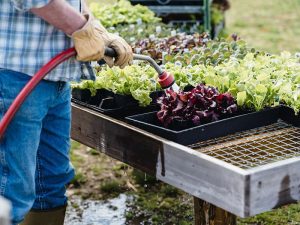Tips and Tricks for Container Gardening
Container gardening is a great way to enjoy the benefits of having a garden without all the hassle. Container gardens are perfect for those who don’t have much space or for those who want to grow their own food and herbs. If you’re ready to get started with container gardening, let’s look at the steps you need to take in order to maintain your plants.
 Do Some Research: What do you want to grow? Can it thrive in your climate? Do a little basic research to make sure the plants you want to grow in your containers are suitable for the space and climate you have. If you’re unsure, you can always speak with an expert at your local nursery who can give you some good advice.
Do Some Research: What do you want to grow? Can it thrive in your climate? Do a little basic research to make sure the plants you want to grow in your containers are suitable for the space and climate you have. If you’re unsure, you can always speak with an expert at your local nursery who can give you some good advice.- Choose Healthy Plants: When you’re shopping for plants to put in your containers, choose healthy ones. While it can be tempting to pick up those clearance plants, if you’re a beginner, you might not have much luck in getting them to grow. Take a good look at the leaves and stems of the plant – if they are wilted or have brown spots, that’s a sign that it might be diseased. Make sure there aren’t any bugs crawling around on them also.
- Choose the Right Sized Containers: Containers come in all shapes and sizes, so you’ll need to choose the right one for your plant. If you’re growing a large plant like a tomato or pepper, you’ll need a big pot – at least 12 inches wide. For smaller plants, like herbs or flowers, a six-inch pot will be plenty big.
- Get Soil: You can pick up soil at most home and garden stores or nurseries that will work just fine for you. Fill your container about halfway with soil (making sure the soil can drain adequately), and then insert your plant in the middle of the container – so the roots have room to spread out. Then fill with soil as needed and pat down gently.
- Water Your Plants: To keep an eye on how much water your plants need. If possible, use rainwater instead of tap water because this will help prevent the buildup of chlorine salts which can damage foliage over time. Additionally, be careful not to overwater, though, as this can cause root rot problems, too.
- Fertilize Occasionally: Fertilizer is essential for healthy plant growth, but over-fertilizing can be harmful, too. If you notice that your leaves and stems are yellowing or turning brown, it’s likely because the plant has been overwatered or received too much fertilizer, and the roots may not be getting enough oxygen. Too much fertilizer will also lead to nutrient burn on the foliage, which manifests as blackened leaf edges. In both cases, stop feeding immediately.
- Place Your Containers in the Sun: Now your container garden is ready for some sun. But be careful if the temperatures rise for an extended period of time. Then it may be beneficial to move your plants to the shade to avoid scorching them.
- Watch for Pests: Yes, your plants can attract unwanted bugs. Keep an eye on them and treat with a bug repellant if needed.
There’s something for everyone when it comes to container gardening – from ornamental flowers like petunias and geraniums to herbs like basil or parsley, which can be used right out of the container. And gardening is a great family activity! Kids will love to see the progress of the plants – and what they produce throughout the growing season.
Recent Posts






